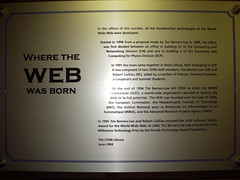Sir Tim Berners-Lee OM KBE FRS FREng FBCS FRSA


Sir Tim Berners-Lee OM KBE FRS FREng FBCS FRSA
(1955-present)
Fellow of the Royal Academy of Engineering, Fellow of the British Computer Society, Knight of the British Empire, Fellow of the Royal Society, Fellow of the Royal Society of Arts, inventor of the World Wide Web (from 1989), WWW consortium Director (from 1994), ACM Software System Award winner (1995), Millenium Technology Prize winner (2004), and Order of Merit recipient (from 2007)
Commemorated on 1 plaque
Where The Web was born. In the offices of this corridor, all the fundamental technologies of the World Wide Web were developed. Started in 1990 from a proposal made by Tim Berners-Lee in 1989, the effort was first divided between an office in building 31 of the Computing and Networking Division (CN) and one in building 2 of the Electronics and Computing for Physics Division (ECP). In 1991 the team came together in these offices, then belonging to ECP. It was composed of two CERN staff members, Tim Berners-Lee (GB) and Robert Cailliau (BE), aided by a number of Fellows, Technical Students, a Coopérant and Summer Students. At the end of 1994 Tim Berners-Lee left CERN to direct the WWW consortium (W3C), a world-wide organization devoted to leading the Web to its full potential. The W3C was founded with the help of CERN, the European Commission, the Massachusetts Institute of Technology (MIT), the Institut National pour la Recherche en Informatique et en Automatique (INRIA), and the Advanced Research Projects Agency (ARPA). In 1995 Tim Berners-Lee and Robert Cailliau received the ACM Software System Award for the World Wide Web. In 2004, Tim Berners-Lee was awarded the first Millenium Technology Prize by the Finnish Technology Award Foundation. The CERN Library June 2004
European Organization for Nuclear Research, CERN CH-1211, Geneva, Switzerland where they developed the fundamental technologies of the World Wide Web

